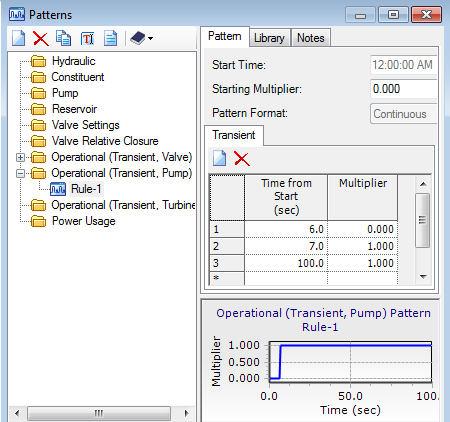| |
Product(s): |
Bentley HAMMER |
|
| |
Version(s): |
08.11.06.58 |
|
| |
Environment: |
N\A |
|
| |
Area: |
Modeling |
|
Problem
When modeling a pump startup transient event, the pump appears to start up too quickly and the initial positive pressure spike appears to be higher than expected.
What is the difference between Speed and Torque for the Control Variable?
Solution
This could be due to the Control Variable and Operating Rule. It's important to note that the multipliers in the Operating Rule multiply against either the full speed or the full torque, depending on the selection you make for the "Control Variable".

Control Variable = Speed
The default is "Speed", in which case the multipliers multiply against the full speed entered in the pump definition, so 1.0 means full speed. This means that you cannot simply "flip the switch" in the Operating Rule pattern and have it go instantly from zero to 1.0 (or within a very small time frame) as it would normally take some time for the pump to "ramp up" to full speed. In the above screenshot, if the control variable was set to "speed", the speed would jump from zero to 1.00 (full speed) between 6 and 7 seconds, and then stays on for the duration of the simulation. This may not reflect how fast the real pump would turn on, in which case the pattern needs to be adjusted to account for that length of time.
If the speed is increased too quickly in the Operating Rule, it can result in an initial head increase / upsurge that is more severe than and not reflective of what would happen in the real system when the pump takes longer to ramp up.
Control Variable = Torque
If you do not know exactly how long it will take for the speed to increase, you can use Torque as the Control Variable. In this case, the multipliers in the Operating Rule pattern will multiply against the nominal torque which you must enter in the pump properties. This "Torque (Nominal)" field represents the electrical torque applied to the pump corresponding to the nominal head and flow (meaning, when the pump is on). Therefore when changing multipliers in the Operating rule, you'll be changing how much electrical torque is applied to the pump, which then controls when the pump starts to speed up. So in the above example screenshot, if the Control Variable is set to Torque, full electrical torque will be applied at time 7 and the impeller will start to speed up based on the inertia. This is more like "flipping the switch".
After computing the transient simulation, you can graph the pump speed using the Extended Node Data tab of the Transient Results Viewer.
Note: if you're not sure what to enter for the nominal torque, you can use trial and error until the results are steady:
1) Change the initial status to On, Pump type (transient) to "variable speed/torque" and Operating Rule to "Fixed"
2) Enter an initial guess on the Nominal torque
3) Change the transient calculation options simulation duration to something short like 5 seconds
4) Compute a transient simulation and look at a time history of flow through the pump - if it is not steady, adjust the nominal torque and repeat until steady. If you see the flow drop, try a higher torque value and vice versa.
5) Change the pump back to off, the transient type to pump startup, select the correct operating rule
See Also
Modeling a Pump Startup
Residual flows different for different pump shut down methods.